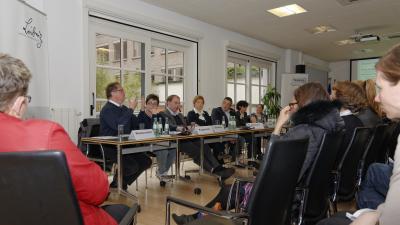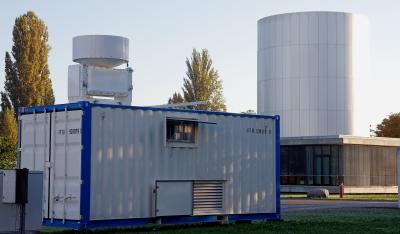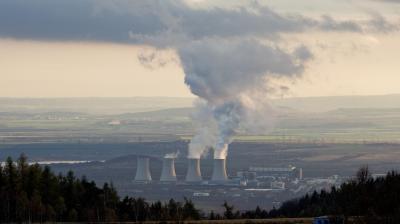Brussels. Scientists have advocated for tightening the Air Quality Directive and expand research on air quality and climate change. Only appropriate investments in research can provide a solid basis for decision making in these areas that have major health and economic consequences for Europe's citizens. In 2013, the European Commission's air policy is reviewed, with a focus on finding ways to improve the quality of the air Europeans breathe. Under the title of „Frontline Research for Improved Air Quality and Climate Action", representatives from science, politics and industry have discussed these matters on Tuesday evening in Brussels upon invitation of the Leibniz Institute for Tropospheric Research (TROPOS). This panel discussion was an official satellite event of the GREEN WEEK 2013 which will be held in Brussels from the 4th to 7th June and – within the "Year of the Air" be entitled "Cleaner Air for All".
Europe's problems with air quality
The polluted troposphere and the associated threats to environment and human health are national, European and global issues that are becoming more and more relevant within the next decades due to increasing urbanization and industrial growth. Research in the field of aerosols and clouds under the roof of the existing and coming European Research Framework Programmes significantly contributes to the review of the European air policy.
Despite the progress of recent years in tackling air pollutants such as sulphur dioxide (SO2), carbon monoxide (CO) and benzene (C6H6), several air quality standards are still widely exceeded in the EU's most densely populated areas, especially from pollutants such as particulate matter, ground-level ozone and nitrogen dioxide. Rising industrial and energy production, burning of fossil fuels and the dramatic rise in traffic contribute to air pollution in our communities and can lead to serious health problems. In spring 2013, the European Environment Agency (EEA) estimated the consequences of air pollution at about 100 million illness related days of absence from work and 350.000 premature deaths in Europe as well as costs of 100 billion EUR per year caused by air pollution originating from road freight traffic alone. Currently, the European Commission is reviewing their air policy and had declared 2013 as the "Year of Air". "The current system of improving air quality underlying the air quality directive needs to be improved steadily in accordance to achieve long-term targets such as the reduction of major pollution sources like NOx and SOx and their compounds. Nevertheless, the thresholds always have to cope with reality and thus can only be fulfilled if one has the means to cope with the causes and not just with its effects," said Holger Krahmer, Member of European Parliament, prior to the event.
Recommendations for a review of the Ambient Air Quality Directive
From the perspective of science, the revision of the Ambient Air Quality Directive provides the chance to set better standards, to improve air quality and to better protect health. "We are consistent with the call for a review of the Directive, which aims at limiting the value for the mass concentration of ultra fine aerosol particles (PM2.5) to 20 μg/m3 from 2013 onwards. By 2020, the limit value of 20 μg/m3 could become binding. This is realistic and should therefore be the objective. "The precondition would be a consequent reduction of particulate carbon from combustion sources," says Prof. Hartmut Herrmann of TROPOS. Carbon in aerosol particles plays a considerable role in our environmental and climate system through natural and anthropogenic emissions, chemical formation and conversion, long-range transport or interactions with clouds and precipitation. Black Carbon (BC) and Elemental Carbon (EC) are very strong indicators of air pollution and a components of soot. "We have indications that low emission zones can reduce the mass concentration of soot in the particulate matter. Setting a target value would be a valuable step into the right direction. Should further measures become necessary, a legally binding value along with requirements for monitoring could follow later on. Particle emissions leading to increased soot mass concentrations in urban areas should strategically be reduced in the long term. Further toxicological and epidemiological studies are needed", says Prof. Alfred Wiedensohler of TROPOS. Both scientists also recommend to regulate benzo(a)pyrene and to set a legally binding limit value for ground level ozone. Putting in place a legally binding ozone limiting value at the current level of target values is a reasonable first step that could be followed by more stringent measures in the future, if necessary, as ozone levels in urban areas still need to be reduced.
Research needs and efforts
The combustion of fossil and contemporary fuels is one of the most prominent aerosol sources and thus for particulate matter. However, these sources are still poorly characterized in terms of climate relevant aerosol properties. According to long-term regional and urban measurements by TROPOS, emissions of particles and their precursor gases are subject to strong physical and chemical transformations, which need to be monitored with high resolution sensors in order to identify the underlying processes.

Under the title of "Frontline Research for Improved Air Quality and Climate Action", representatives from science, politics and industry have discussed these matters on Tuesday evening (14th May 2013) in Brussels upon invitation of the Leibniz Institute forTropospheric Research (TROPOS). This panel discussion was an official satellite event of the GREEN WEEK 2013 which will be held in
This shows Brussels from the 4th to 7th June and within the "Year of the Air" be entitled "Cleaner Air for All".
(Photo Credit: Photo: Tilo Arnhold/TROPOS)
Together with measurements, computer models that simulate the emission, transport and transformation of air pollutants help to understand and quantify such processes.
„Detailed knowledge of optical, microphysical, and radiation properties of aerosol particles is of vital importance in order to understand their role in atmospheric processes as well as their impact on human health and environment. Sustained long-term observations of these aerosol properties can be accomplished only from multiple coordinated in-situ and ground-based remote sensing stations, complementing satellite observations which do not have a sufficient temporal and even spatial coverage and continuity to study many processes and do need ground-based measurements for calibration and validation. "A pan-European Research Infrastructure for atmospheric observations is the only instrument for providing these coordinated and sustained long-term high quality observations at continental scale", says Dr. Gelsomina Pappalardo, Coordinator of the FP 7 Aerosols, Clouds, and Trace gases Research Infrastructure Network (ACTRIS) and Member of the National Research Council of Italy.
Infrastructures and networks are important tools
To efficiently join European efforts in that field, European Research Infrastructures play a vital role for the work of the scientific community. International knowledge transfer and cooperation facilitate scientific progress and help to establish and finance programmes and projects that could not be realised on the national level. European Measurement Networks and Research Infrastructures aim at systematic analyses and policy advice for a better air quality. This, however, demands for long-term research strategies. The European infrastructures "In Service Aircraft for a Global Observing System" (IAGOS), "Aerosol, Clouds, and Trace Gases Research Infrastructure" (ACTRIS) and "Integration of European Simulation Chambers for Investigating Atmospheric Processes" (EUROCHAMP) strongly participate in these processes.
IAGOS-ERI is one of the European Research Infrastructures (ERI) on the ESFRI Roadmap. IAGOS-ERI will establish and operate a distributed infrastructure for long-term observations of atmospheric composition on a global scale from a fleet of 10-20 long-range in-service aircrafts of internationally operating airlines.
ACTRIS is a European Project aiming at integrating European ground based stations equipped with advanced atmospheric probing instrumentation for aerosols, clouds, and short-lived gas-phase species. ACTRIS will therefore play an essential role in generating new knowledge for further research and policy advice in the fields of climate change, air quality, and long-range transport of pollutants.
EUROCHAMP-2 (European Simulation Chambers for Investigating Atmospheric Processes) is a European project which aims at a better integration of simulation chambers for studying atmospheric processes. Today, 14 European Partners are the backbone of this project, which developed a grid of environmental chambers. „Fine particulate matter and nitrogen dioxide (NO2) are the key problems for increasing air quality in Europe. Whereas particulate matter and the exceedence of PM limiting values have attracted considerable public attention during the last couple of years, the NO2 problem is a relatively new one, which became mature through the introduction of new European limiting values in January 2010. For a further improvement of air quality, a detailed understanding of the corresponding atmospheric processes is prerequisite. Field studies and modeling work alone cannot provide the necessary information. Atmospheric simulation chambers offer the unique opportunity to study atmospheric processes related with air quality without the interference of meteorology. Therefore, these simulation chambers can help to further improve air quality in Europe", says Peter Wiesen of University of Wuppertal, Germany, who coordinates EUROCHAMP.

The mobile cloud radar lacros (left) and the stationary cloud laboratory LACIS (right) of TROPOS in Leipzig. LACIS is one of the experimental laboratories for the investigation of atmospheric processes in Europe, united in the network EUROCHAMP-2. This research infrastructure provides an important contribution to improving air quality.
(Photo Credit: Photo: Patric Seifert/ TROPOS)
Impact on the changing Earth's climate
Setting Air policy standards and ceilings, identifying sources and transport ways of particulate matter and the impacts on cloud formation processes are strongly linked to the changing Earth's climate. „Recent scientific studies have shown that simultaneously improving air quality and tackling climate change is possible, also through the avoidance of particulate matter emissions. These measures help reducing concentrations of strongly absorbing particles that have an adverse effect on human health and they thus improve air quality already close to the sources such as in cities. Although particles have a short lifetime (up to 7-10 days), they can travel far enough from European sources to be then deposited on remote environments, such as the Arctic, exacerbating the effect on climate. Significant results have been obtained in the past in understanding aerosol properties and their role in the atmosphere but work has still to be done to know better how to mitigate their adverse effects," says Dr. Elisabetta Vignati, Head of the Air and Climate Unit in the Joint Research Centre, the scientific centre of the European Commission in Ispra, Italy.
In current climate models the roles of aerosol particles and as well the role of clouds in the climate system are not yet fully understood. This is mainly due to the complex interaction of clouds and radiation and the large variability of their physical properties on a wide range of scales. That means there is still a lot of work for scientists to do.

The coal power plant Tusmice in northwest of Czech Republic. Despite the progress of recent years in tackling air pollutants such assulphur dioxide, carbon monoxide and benzene, several air quality standards are still widely exceeded in the EU's most densely populated areas, especially from pollutants such as particulate matter, ground-level ozone and nitrogen dioxide. Rising industrial and energy production, burning of fossil fuels and the dramatic rise in traffic contribute to air pollution in our communities and can lead to serious health problems.
(Photo Credit: Photo: Tilo Arnhold/TROPOS)